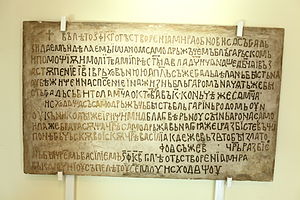Nicholas (komes)

The komes ("count") Nicholas (Bulgarian: Никола, romanized: Nikola) was a local ruler in Bulgaria, and progenitor of the Cometopuli ("the sons of the count") dynasty.
According to the Armenian chronicler Stephen of Taron, the family originated in the Armenian region of Derdjan,[1][2] where their sons were born. However, Michael Palairet affirms that count Nicholas' family name is Shishman, a family name not of Armenian origin, which centuries later became a Bulgarian royal dynasty.[3] He was married to Ripsime or Hripsime, seen as a daughter of King Ashot II of Armenia.[4][5][6] However, Ashot ll and his wife Marie of Kachen are not known to have had children. The couple had four sons, David, Moses, Aron, and Samuel, who are collectively known as the Cometopuli (from Greek Kometopouloi, "sons of the komes"; Armenian կոմսաձագ Komsajagk).[1][2] Sometime in the 970s—the exact date is unclear and disputed—the brothers launched a successful rebellion against the Byzantine Empire, that had recently subdued Bulgaria; after the early death of his brothers, Samuel remained as the undisputed leader of Bulgaria, ruling as Tsar from 996 until his death in 1014.[7]
Other than that, nothing is known of Nicholas.[1] He may have ruled Serdica[8] or, according to other sources, was a local count in the region of the modern North Macedonia.[9] The family appanage was located above the village of Palatovo, according to legend and a number of archeological data in the neighborhood. [10]
In 992/3, Samuel erected at German, near Lake Prespa, an inscription commemorating his parents and his brother David.[1]
Family tree[edit]
| Ashot II of Armenia | Marie of Artsakh | ||||||||||||||||||||||||||||||||
| Count Nicholas | Ripsimia of Armenia | ||||||||||||||||||||||||||||||||
| David | Moses | Aron | Samuel of Bulgaria | ||||||||||||||||||||||||||||||
| Ivan Vladislav of Bulgaria | Gavril Radomir of Bulgaria | ||||||||||||||||||||||||||||||||
References[edit]
- ^ a b c d PmbZ, Nikolaos (#26038.
- ^ a b ODB, "Kometopouloi" (A. Kazhdan), pp. 1140–1141.
- ^ Michael R. Palairet (2016) Macedonia. A Voyage through History (Vol. 1, From Ancient Times to the Ottoman Invasions). Cambridge Scholars Publishing, p. 222, ISBN 9781443888431.
- ^ Adontz, Nicholas (1938). "Samuel l'Armenien, roi des Bulgares". Mar BCLSMP (in French) (39): 37.
- ^ David Marshall Lang, The Bulgarians: from pagan times to the Ottoman conquest, Westview Press, 1976, p. 67.
- ^ Tom Winnifrith, Badlands, Borderlands: A History of Northern Epirus/Southern Albania, Duckworth, 2002, p. 83.
- ^ ODB, "Kometopouloi" (A. Kazhdan), pp. 1140–1141; "Samuel of Bulgaria" (A. Kazhdan & C. M. Brand), p. 1838.
- ^ Prokić, Božidar (1906). Die Zusätze in der Handschrift des Johannes Scylitzes. Codex Vindobonensis hist. graec. LXXIV (in German). München. p. 28. OCLC 11193528.
{{cite book}}: CS1 maint: location missing publisher (link) - ^ Southeastern Europe in the early Middle Ages. Florin Curta. page 241
- ^ Interview with Georgi Georgiev, historian from Dupnitsa
Sources[edit]
- Kazhdan, Alexander, ed. (1991). The Oxford Dictionary of Byzantium. Oxford University Press. ISBN 978-0-19-504652-6.
- Lilie, Ralph-Johannes; Ludwig, Claudia; Zielke, Beate; Pratsch, Thomas, eds. (2013). Prosopographie der mittelbyzantinischen Zeit Online. Berlin-Brandenburgische Akademie der Wissenschaften. Nach Vorarbeiten F. Winkelmanns erstellt (in German). De Gruyter.
